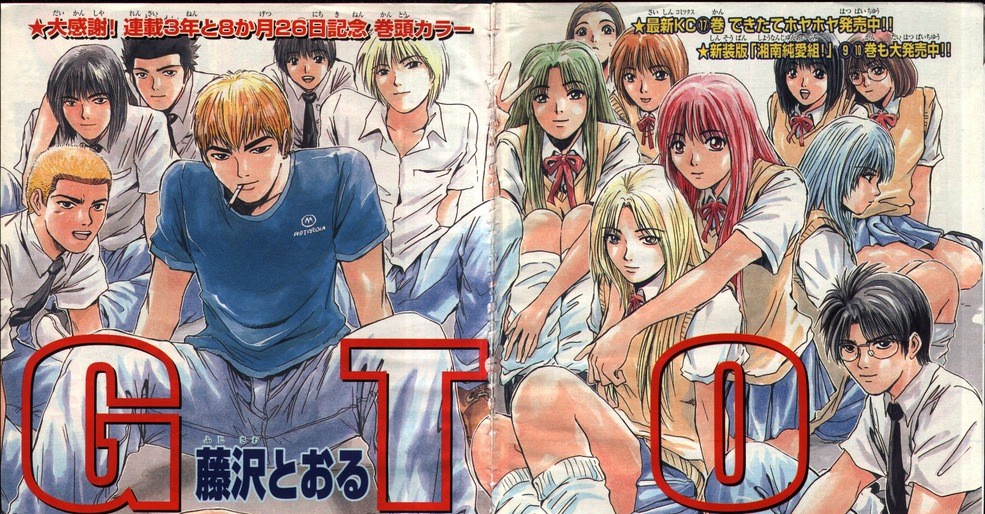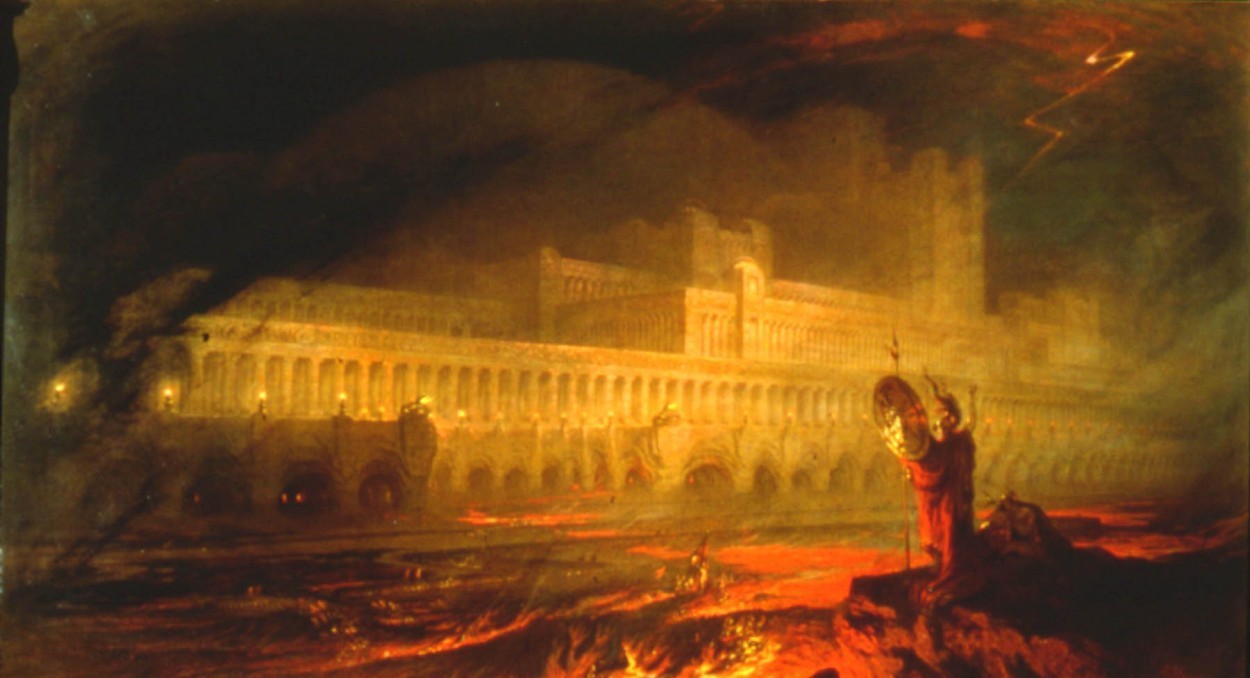Diablo II is one of my favorite games of all time. It’s one I have a lot of affection for, and it’s still to this day the game I’m most likely to go back and play on a whim. I shouldn’t though, because Diablo III exists.
Diablo III gets a lot of undue hate, but it only seems to be coming from people who played its predecessor. Saying “it’s not Diablo II” is a fact, not an argument. That’s how sequels work! They come after the things that come before them. Diablo III may not have lived up to its expectations, but that’s because through the Crimson Spectacles of Nostalgia, what was perfect could never be improved.
It pains me to say this, if only because the truth of it rings with all the gravity of a funeral knell, that yes, Diablo II was that good of a game, but gameplay and mechanics-wise, Diablo III is completely superior.
So go ahead and criticize Diablo III. Honestly, you’ve got plenty of arrows in that quiver. Its launch-day auction house was a travesty, and its grade school-quality story is a joke. But toss up your dueling banner against its tight, razor-focused mechanics, and you’ll see you’re on the losing end.
Out with the Old
There’s no question that Diablo III took major leap attacks to streamline what I consider to be the definitive Diablo experience. Blizzard wanted its long-awaited sequel to appeal to a broader audience. Construe this as “selling out” if you must, but what resulted was a more focused hack and slash experience. To get their game where they wanted it, Blizzard took to the chopping block a number of Diablo II’s features, which even in 2001 were cumbersome.
Stat distribution. I know, I know; you’ve been pumping stats into your characters since you wore +2 Diapers of Absorption. Manual stat distribution is a standby of not only those late night D&D sessions but the many computerized RPGs that followed. Diablo II continued this tradition (to sometimes hilarious effect), but with one major caveat: stats you allocated were permanent, and they couldn’t be reset. For a game that has you investing hours upon hours into a character, the risk of fucking him or her up forever is very, very real. Blizzard eventually added a stat reset function, but it’s only available 3 times (one for each act). After that, you have to farm items in Hell (figuratively speaking). This pretty much boned players who liked to experiment to find what worked for them. And even if you’d done your research, a laggy computer could have you wasting your points in areas you didn’t need.
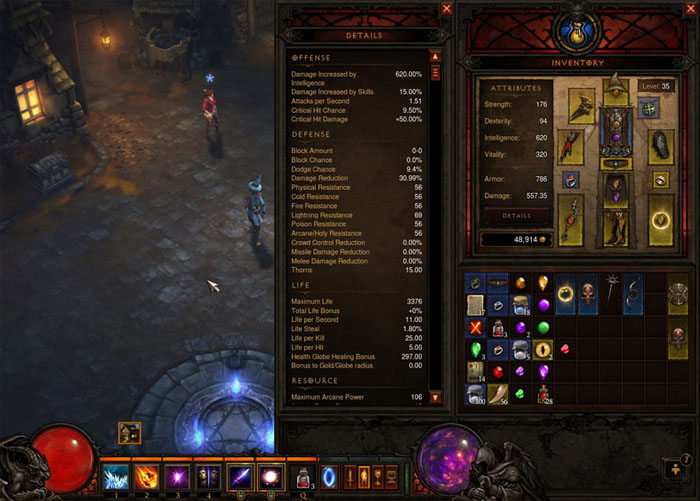
Diablo III doesn’t do away with stats completely; its RPG roots still run deep. Instead each class is assigned a primary stat that increases his or her damage as well as crit chance, crit damage – pretty much everything that makes your character plough through baddies faster than Guy Fieri goes through hair bleach. You don’t even have to add these yourself; they get applied on the fly. Although manual stat distribution was later added with the addition of Paragon levels, the stats you were increasing could only ever help you, not hurt you. And even then you could reset your points for absolutely free, meaning you’d never find yourself stuck with a build you didn’t like. So while we can all mourn the loss of manual stat distribution, the reality is that doing away with it created a faster-paced, more rewarding game.
Trash skills. Lord of Terror knows I love that Poison Dagger exists, but it’s straight-up garbage. Seriously! Even if you have all the right gear to make “the Daggermancer” work, the namesake skill still takes a backseat to Poison Nova. This skill and many others like it show off creative design yet lack the foresight of a sustainable thing people will actually want to use later on in the game. I’m all for skill progression, but considering you could only work toward maybe one or two viable damage-dealing builds per character by endgame, that’s a lot of stuff sitting the game out. The introduction of skill synergies with the godsent Patch 1.10 helped out a lot, as it gave you places to spend your benched skill points and make ’em buff up the few actually useful skills of your class, but they didn’t make the skills themselves any more exciting to use.
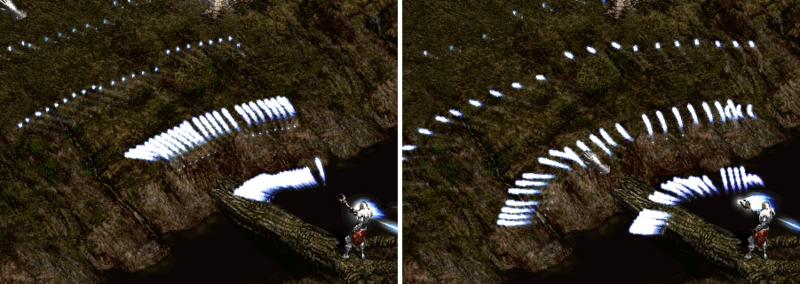
Diablo III fixed this by asking, “is this skill awesome? Will players want to use it in later levels? Are there cool, niche builds players can uncover with it? Does it synergize well with other skills?” In asking these questions, we got powers that were not only cool but didn’t feel like throwaways. Compound this with the ability to stamp your own personal style on them and make them your own by fitting skills with one of a handful of unlockable added effects, and now your jars o’ spiders could leech mana if you so chose, or your poison death clouds could spawn slimes that furthered your reign of putrefaction.
And before you argue that there are forum threads out there by players (or robots, or bored mathematicians) who have revealed the absolute best gear and skills to output the optimum amount of damage, there’s less of a burning need to in Diablo III. This isn’t an MMO, with raid leaders breathing down your neck and secondary DPSers criticizing you so that when the time comes for loot distribution they can claim you weren’t pulling your weight. You can play by yourself – all the loot is yours anyway, and you never have to play with another soul if you so choose.
Also consider the fact that there were monsters in Diablo II’s highest difficulty who were absolutely and completely immune to your only viable skill. That cold sorc you built? Pretty proud of being able to Frozen Orb everything in the game? You just came across an immune to cold Lord de Seis, and if you don’t kill him, you’ll never leave Act IV. Welcome to Hell, for real.
Added Value
No proper game sequel is without the addition of a few improvements. Because as many features that get replaced, simplified, or otherwise trashed, developers have to add new stuff. It’s, like, a given. For Diablo III, Blizzard added mechanics that not only improved on what was already a solid model for the time but helped to define the hack and slash genre even further.
Boss fights that matter. Don’t get me wrong, I love launching Frozen Orbs across that coagulated meat river in the Durance of Hate Level 3 as much as anybody, but that doesn’t qualify as a boss fight any more than chucking empty beer bottles into the recycle bin qualifies as basketball practice. Same with kiting Andy around her lair with a single HP, trying not to step in any fires or get thwacked by that random Fallen who somehow slipped past what you thought was a routine dungeon cleanse. Instead Diablo III took a cue from another in-house franchise (maybe you’ve heard of it) and tailored each boss fight to provide a unique experience. It’s the equivalent of knocking back a Coors Light versus sipping a craft beer; one is a vastly more unique and enjoyable experience than the other (and if I have to tell you which, we are going to have some not-so-metaphorical problems).
To sum, every boss fight in Diablo II went like this:
1. Enter the fray
2. Deal damage
3. Run away
4. Take unavoidable hits
5. Repeat steps 2-3
6. Collect loot
Not exactly the most complex thing, yet I did it over and over. I still do it. It’s mindless monster-bashing at its best, but it was also all the game offered. Compare this to Diablo III’s boss fights, like the one against Belial, Lord of Lies:
1. Enter the fray
2. Deal damage
3. Dodge damage
4. Watch out for meteor strikes!
5. Kill adds!
6. Take unavoidable hits, but only if you weren’t paying attention
7. Repeat steps 2-6
8. Collect loot
It’s so much more engaging to have gameplay you have to think about compared to the mindless clickspam of the past. I mean, I like mindless monster-bashing, and Diablo II’s has top honors in the halls of my heart, but boss fights in that game were no different than fighting any other monster except for the bigger health bars and flashier abilities.There was nothing about Diablo II that showed me I could bash monsters and be interested too.
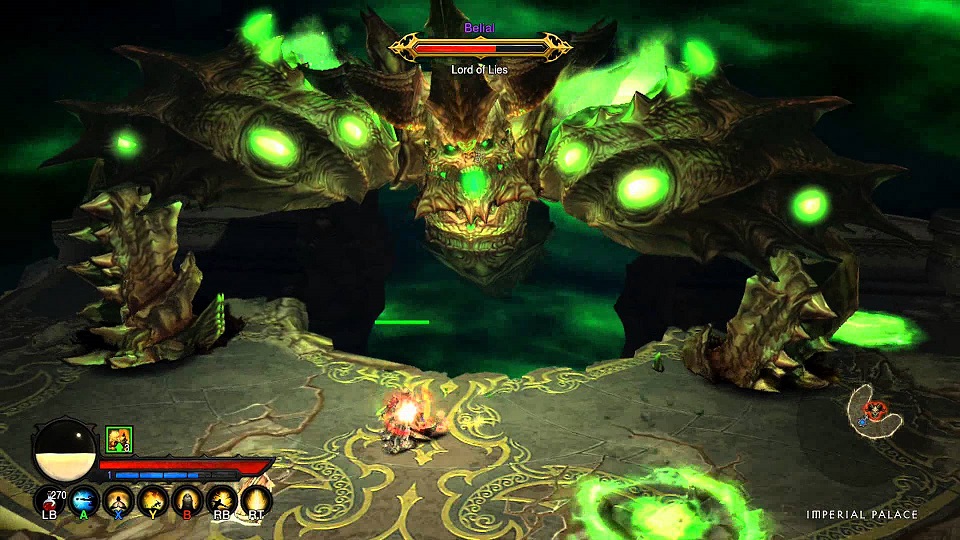
Like, I thought I knew what I signed up for when I bought a Diablo game. It’s like I had brought the knife I’d been dulling on monster hide for the past 12 years, the one with the serrated blade and bone-white handle, only to find that Blizzard brought a gun to the fight, and the gun shoots red-hot flak. It was a completely surprising yet delightful surprise.
An endgame. Whenever I go back to play Diablo II, Baal and Meph runs usually make up roughly 60% of my playing time. After soloing the game in hardcore mode, I inevitably fall into the sole gameplay loop Diablo II has going for it. “Doing runs,” which has you load your character with magic find gear to kill bosses who drop high level items, is not actually part of the game. Oh, the bosses were in the game, but I wonder if Blizzard knew the kind of autistic repetition players would popularize. To be honest, I love when player behavior spawns a game mechanic like this, but the lack of a proper endgame can only keep my interest for so long.
Diablo III wasn’t exempt from this at launch; you beat the game once, then went through it again over several more difficulties. Been there, done that. Even the random monster encounters, special zones, and loot drops weren’t enough to differentiate these runs. However, this was all fixed once Blizzard patched in Paragon levels, which propelled your character beyond its fixed level cap. Instead of Diablo II’s mundane stat and skill points, which capped at level 99 anyway, you could boost your gold find, AoE damage, life leech, and other more exciting attributes. It didn’t matter your character was no longer leveling up if you got the means to kill thing faster and find items to make him or her stronger. It feeds back into that addicting gameplay loop that Diablo II was so famous for, the neverending feeling of “just one more run” that somehow found you staring at your monitor at 4 AM, alone in a game titled baal run 75. Paragon levels gave you something to work toward that wasn’t just leveling up the number next to your name.
Diablo III’s expansion Reaper of Souls took endgame even further with Adventure Mode (randomized quests!), Enchanting (stat gambling!), Transmogrification (dress up simulator!), Clans (the social network!), and more. It’s an elegant and organized effort to keep players interested with random experiences while pursuing goal-based objectives.
How I Learned to Stop Worrying and Love the Sequel
I’ll miss its fantasy grimdark aesthetics. I’ll miss the patented “Diablo humor,” which felt a part of the world, a product of the dour times, that was markedly distinct from the farcical “Blizzard humor” that’s forced down our throats these days. But realistically, I could talk about the things I didn’t get in Diablo III just as much as I could talk about the fan service I did get: the armor dyes, character-unique resources, crafting, Whimsyshire. There are things about Diablo III I’ve only just barely scratched the surface of that could warrant an article all their own. It’s pointless to pine for a game that captures the soul of a Diablo game when Diablo III: The Game is what I’d rather be playing.
Diablo III is by no means an underdog (it’s sold over 30 million units across all platforms), but it needs defending from people like me, who would rather build yet another Hardcore trap assassin than roll their very first demon hunter. The love I have for Diablo II is rooted in nostalgia, which makes for a near-impossible opponent no matter how many improvements or additions you make. I didn’t need Diablo III to give me something new to love – I’m perfectly capable of booting it up the old thing and playing it anytime I want – but Diablo III deserves to be commended for giving me, for giving all of us, more than we deserve.






